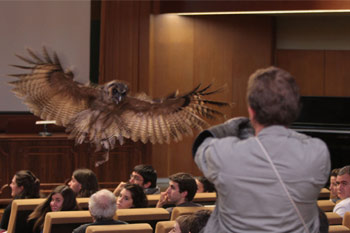''I am concerned that the children have lost contact with natural life.''
Luis Lezana, Ph.D. in Biology, performed an exhibition with birds of prey for students from high school diploma in the 2011 Science Weeks

Luis Lezana, graduate and PhD in Biology from the University of Navarra and promoter of Sturnus S.L., has made an exhibition with birds of prey on the occasion of the Science and Technology Weeks 2011.
This sample, which was attended by more than 100 students from three schools, was completed with an overview of the art of falconry, its history and its application in new high school diploma from three schools, was completed with a review of the art of falconry, its history and its application in new employment opportunities as the business Sturnus. Luis Lezana talked about all this in an interview for the University of Navarra.
- As graduate and doctor in Biology, what did you find in falconry to consider it as a professional career?
Actually, falconry was what led me to study Biology, since my relationship with birds of prey comes from my childhood. When I was 4 years old I started training small birds such as kestrels in the Zoo that my father had in Calahorra next to the emblematic Félix Rodríguez de la source. Later, after getting my doctorate at the University I observed that I could apply this millenary art to the control of certain vertebrate pests such as starlings (birds on which I did my thesis ). In this way I could solve some serious problems for citizens in relation to some pests.
- To what extent is Sturnus, your business, an innovative initiative in Spain?
Sturnus Control is a pioneer business in many aspects of pest bird control. For example, it is the only business that guarantees the control of starling pest populations throughout Spain, by means of what we call combined control, exercised with deterrent devices among which the birds of prey themselves stand out.
By means of this system we achieved the record of more than 2,500,000 birds driven away from the urban area of Logroño in 2005. We have also patented bird repelling systems such as the one we have installed in the Basilica del Pilar to prevent its deterioration due to pigeon droppings. We also solve the problem of heavy stork nests in churches and other buildings of heritage interest by translocating these nests to their natural habitats.
- One of the objectives of your business is the environmental Education . Are we moving further and further away from the natural environment and the way of working and living with animals?
Totally. One of the things that attention always tries to spread to the future biologists of School is that they should not neglect attention with the people in the field. They are an open book of knowledge about the habits and lifestyles of the wildlife around us. Sometimes biologists and the Administration in general work in a completely aseptic way, in a deformed reality of our environment, applying only theoretical aspects of Biology and Population Ecology without basing their environmental management on more transcendental aspects, such as individual or population behavior of wild species. I am also concerned that children have lost the contact with natural life, to the point that many do not know what a partridge, a hedgehog, a squirrel is. They even ignore such elementary aspects as where food such as milk, cheese or eggs come from. If this continues, these children will hardly be good guardians of natural life tomorrow.
- How would you evaluate the status of birds of prey in general in Navarra and in Spain?
The current status is very different depending on the species we are valuing. For example, buzzards, black kites, kestrels, golden eagles, eagle owls and vultures, whose feeding and nesting habits may vary according to the availability of resources, have adapted more or less well to the changes exerted by man in their habitats. Moreover, thanks to activities such as supplementary feeding, landfills, protection of new areas or reserves, etc., they are going through a good status . Other less adaptable species have been negatively affected by human encroachment on their living space, with a significant reduction in their populations. This is the case of eaglets, short-toed eagles, Egyptian vultures and the most dramatic case in Navarra, as it is on the verge of extinction, the Bonelli's eagle. Likewise, and as also happens in the region, the withdrawal in recent years of farmhouses, which were home to several species of raptors, has contributed to the decline of certain species such as owls and owlets.
- How do raptors work for pest control?
Our raptors are in charge of scaring migratory starlings, which every year invade the trees of the University of Navarra and the University Clinic, from their winter roosts. Before our birds started working there, starlings invaded thousands of pine and chestnut trees at the University. Especially in the Hexagon Building and the surrounding area, where there were more than 15,000 roosting birds. The plague of starlings caused discomfort due to their screeching throughout the night -something especially harmful for the patients at the Clinic-, generated unhealthiness and bad odors due to the accumulation of droppings; they deteriorated the materials where they settled and posed a risk of transmitting zoonotic diseases, etc. Finally, Sturnus completely chased away the starlings in its first year of operation and now we continue to prevent the entry of new birds.
